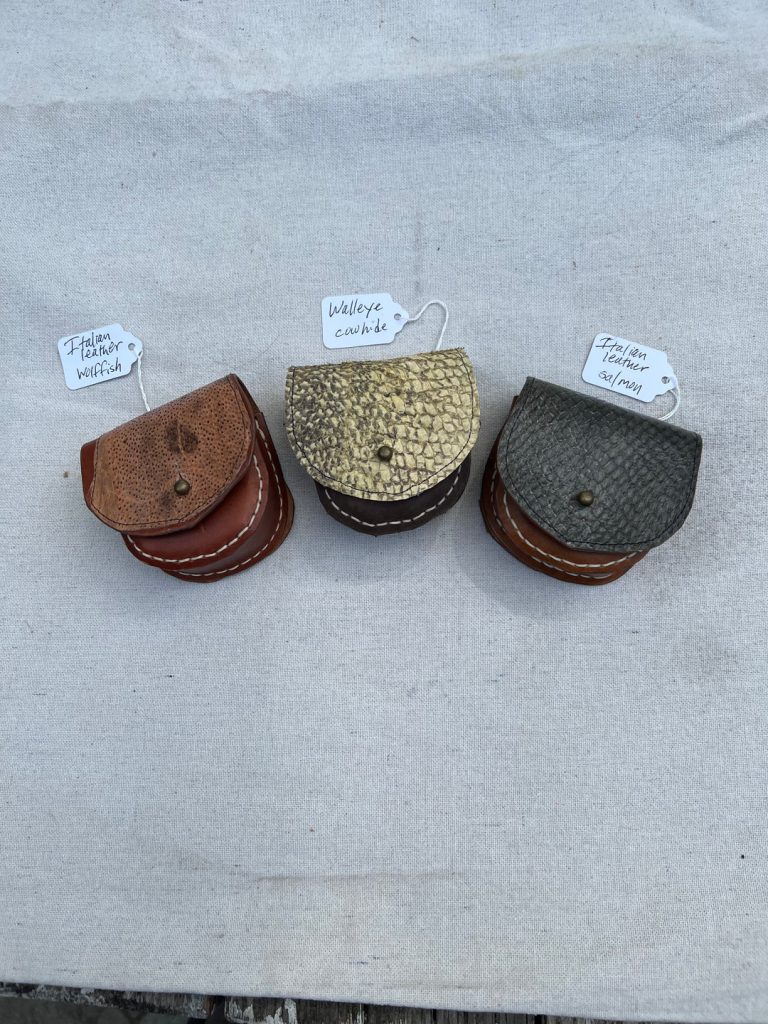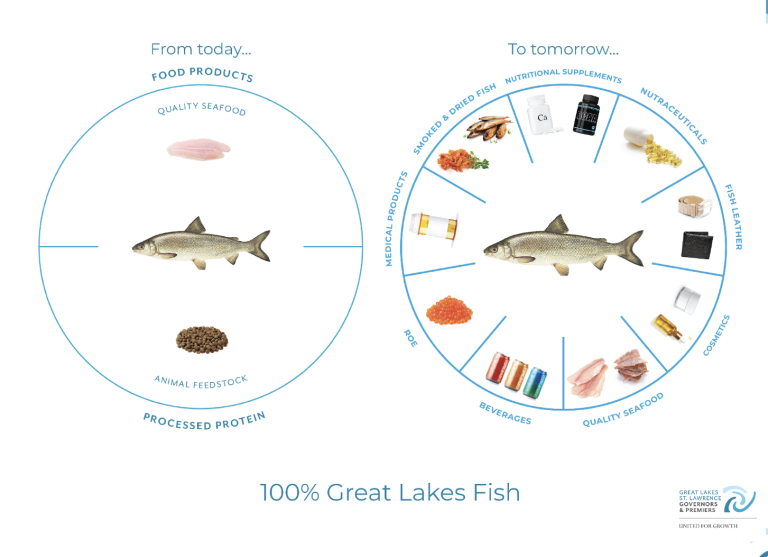
Joe Manthei
Lake trout and whitefish leather dyed with natural indigo.
By SHEALYN PAULIS
Capital News Service
LANSING — Fish-leather purses and wallets could enter Great Lakes fashion with an initiative to use 100% of commercially caught fish by 2025.
One of the newest projects of a binational Great Lakes organization is to fully exploit the region’s whitefish, lake trout, yellow perch, walleye and white sucker.
David Naftzger, the executive director for the Conference of Great Lakes St. Lawrence Governors & Premiers, recently signed 20th company on the 100% fish pledge.
Participants include four from Michigan: Motor City Seafoods in Detroit, VanLandschoot & Sons Fish Market in Munising, AA Marine in Manistee and First Catch LLC in L’Anse.
The conference is made up of the heads of the eight states and two provinces bordering the Great Lakes. It was established to grow the regional economy and protect the world’s largest surface freshwater system.
The pledge exposes the public to the number of ways to use fish, Naftzger said.
“There are food products that you can make from non-traditional fish parts, but to show that you can use more of each fish, and that a fish is not just a fillet.” Naftzger said.
Commercially caught fish are mainly used for their fillets, according to project details. About 60% of the remaining fish become low-value animal feed or are thrown away.
Commercial fisheries in the region are undervalued and underutilized, according to project managers.
The project team also includes Native American communities: The Red Cliff Fish Co., Chippewa Ottawa Resource Authority, Grand Traverse Band of Ottawa and Chippewa Indians, Great Lakes Indian Fish & Wildlife Commission and the Little Traverse Bay Bands of Odawa Indians .
Commercial fishing in the Great Lakes is a $7 billion-a-year industry.
Using 100% of commercially caught fish means expanding and sustaining a profitable lake economy and culture. The pledge details how a fish can be turned into a product, increasing income and eliminating waste.
Fish skin can be made into leather and artistic materials. Collagen can be used as pharmaceutical supplements. Oils and collagen can be used in cosmetics and creams.
Fish skins have been used to treat burn victims because of their anti-inflammatory and anti-bacterial properties that support and improve wound healing. Nutrients from their flesh and bones can be made into medicines and collagen drinks.
Any leftovers can be turned into organic liquid fertilizer.
The project was inspired by the Iceland Ocean Cluster, a group that pioneered and runs a similar campaign in Iceland. As a result of this initiative, more than 90% of each fish is consumed or processed.
A study by the Iceland Ocean Cluster suggests that one of the promising sites for research and development of the full use of fish may be near Mackinaw City, which is close to urban areas, fisheries, processing plants, restaurants and research center.
Bill Bodin, a fourth-generation commercial fisherman whose family has been fishing near Wisconsin’s Apostle Islands of Lake Superior since the 1880s, says he now uses 100% of the fish he catches.
Since he is no stranger to sustainability, Bodin said he has more goals for his participation in the program. “To see these leaders working to create a larger enterprise to promote sustainable, healthy fish populations and use resources to the maximum is a breath of fresh air.”
He said, “At this point, I hope that commitment will help create additional markets around collagen, fish oil, fish scales, fish skin.” These are “things we’re currently not getting the most out of.”
Joe and Pam Manthei own and operate Fiskur Leather, a Minnesota company that uses fish scraps to create leather for clothing, artistic materials and jewelry.
The couple learned about tanning fish skins while on vacation in Iceland and brought the idea to the United States.
They first imported Icelandic fish to work with but soon learned that Bodin Fisheries was willing to send scraps to experiment, Joe Manthei said.
He processes and tans the fish and his wife makes artistic materials from the leather. Together they create wallets, boots, bags, necklaces, buttons and jewelry.
“The interesting thing is, it’s very thin but very durable.” Joe Manthei said.
Fish leather is considered one of the strongest and most durable because the skin runs crosswise instead of parallel, he said.
“We use some of the products that would normally be thrown away,” says Joe Manthei. “I am in favor of all of this [the pledge] is being done.”
Naftzger said the 100% Great Lakes Fish pledge is a non-traditional collaboration among indigenous tribes, commercial fishing companies, the research community and international partners to demonstrate to businesses and the public that every part of the fish thrown away is a lost opportunity to create new products and rethink value in the fishing industry.
“We will work over the next two years to support companies that are already using 100% of their fish to move up the value chain, and for those that are not, help them get to 100% use.” Naftzger said, “Over time, we hope to attract new companies and come up with new products that we might not be thinking about now.Shealyn Paulis writes for the Great Lakes Echo.

Joe Manthei
A small bag made of fish skin.

Conference of Great Lakes Governors and Premiers of St. Lawrence
How commercial fish catches are used today and what could be possible if they were fully utilized.


